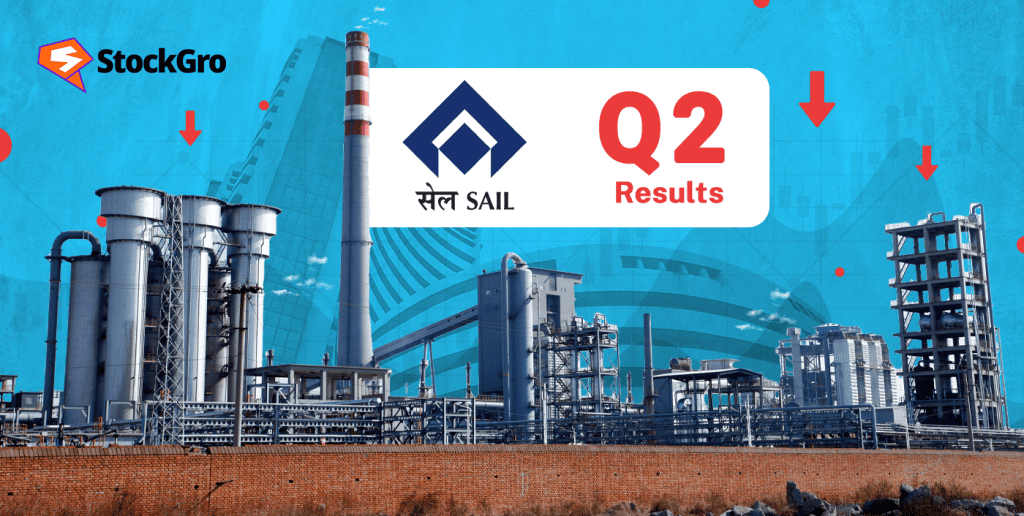
SAIL’s Q2 FY25 Results: A Closer Look
The Steel Authority of India Ltd (SAIL), one of India’s largest steel producers, recently reported disappointing Q2 FY25 results. The stock responded swiftly, declining up to 7% intraday before settling at a 4% drop. Amid weak global steel demand and increased low-cost imports, SAIL’s performance fell below market expectations, reflecting broader challenges facing the steel industry.
Highlights of SAIL’s Q2 Performance
- Net Profit: Declined by 31% year-on-year (YoY) to ₹897.2 crore from ₹1,305.6 crore.
- Revenue: Fell by 17% YoY to ₹24,675.2 crore, down from ₹29,712.1 crore.
- EBITDA: Dropped 24.8% to ₹2,912.8 crore, with margins narrowing from 13% to 11.8%.
- Expenses: Reduced by 14.2%, largely due to inventory adjustments, amounting to ₹23,824.1 crore.
The revenue and profit decline signals not only weaker domestic demand but also the pressure from cheaper steel imports, especially from countries like China, South Korea, and Vietnam.
Also Read: Amara Raja Shares Surge on Major Licensing Deal
Why Did SAIL’s Profits Take a Hit?
1. Weak Steel Demand and Price Pressures
SAIL’s Q2 financials reveal the impact of weakening steel prices, which dropped to their lowest in three years. Steel prices have been squeezed as manufacturers face reduced domestic and international demand, further exacerbated by rising imports.
2. Inventory Challenges
SAIL’s accumulated inventory has also posed challenges. The company is currently managing iron ore and steel inventories valued at nearly ₹4,000 crore, adding pressure on cash flow and profitability. This inventory is subject to market fluctuations, creating an uncertain outlook for its valuation and disposal.
3. Operational Decline
SAIL’s crude steel output for the quarter was nearly unchanged at 4.76 million tonnes (MT) compared to last year. However, sales volumes slipped from 4.77 MT to 4.10 MT, indicating weaker market demand for steel products, despite efforts to manage production levels.
You may also like: RVNL and Ircon shares Drop 7% on Weak Q2 Results
Value Insights: Key Financial Metrics for SAIL
| Metric | Q2 FY25 | Q2 FY24 |
| Net Profit | ₹897.2 crore | ₹1,305.6 crore |
| Revenue | ₹24,675.2 crore | ₹29,712.1 crore |
| EBITDA | ₹2,912.8 crore | ₹3,875.4 crore |
| EBITDA Margin | 11.80% | 13% |
| Crude Steel Production | 4.76 MT | 4.76 MT |
| Sales Volume | 4.10 MT | 4.77 MT |
How Did the Market React?
Following the Q2 results, SAIL’s shares took a sharp downturn. Opening at ₹120.50, the stock fell to an intraday low of ₹114.88 on the NSE, reflecting a 7% drop from the previous close of ₹123.36. Investors, concerned by SAIL’s weak financial performance, contributed to this decline, with the stock ending the day around 4% lower.
This pullback adds to SAIL’s ongoing downtrend, as the stock has dropped more than 25% over the past year. Despite this, SAIL’s management is optimistic about the second half of FY25, with hopes of improving demand conditions and a reduction in steel imports.
Also read: Rail Vikas Nigam Ltd (RVNL) rides high with ₹ 65,000 crore order book
SAIL’s Strategic Response to Challenges
Optimising Inventory and Costs
SAIL is working on an inventory management plan, aiming to liquidate or utilise its iron ore and steel stock. Additionally, the company is benefiting from a drop in raw material prices, specifically iron ore and coking coal, which could aid in partially offsetting operational pressures.
Capitalising on Domestic Infrastructure Growth
SAIL expects an improvement in demand, driven by India’s ongoing infrastructure projects and economic growth. Investments in sectors like railways, construction, and manufacturing could boost steel demand domestically, providing a tailwind for SAIL’s performance.
Focused Efforts for H2 FY25
Commenting on the quarter’s results, SAIL Chairman Amarendu Prakash expressed optimism for the second half of the financial year. With a potential easing of import pressures and continued government capital expenditure, Prakash expects a better performance in H2 FY25.
You may also read: Charging ahead: Exide Industries and Amara Raja Batteries in focus
Is SAIL a Good Investment Right Now?
For investors looking to enter or stay in the stock, here are some key points to consider:
Prospects for Rebound
SAIL’s strategic steps towards managing inventories and reducing operational costs show resilience. Combined with potential demand from government-led infrastructure projects, the long-term growth prospects remain attractive, despite short-term headwinds.
Challenges Ahead
In the near term, SAIL will continue to face pricing pressures due to steel imports and fluctuations in raw material costs. Until demand improves, the company’s stock may see volatility, making it a high-risk investment in the short run.
Also read: What does the EV boom mean for auto stocks?
Key Takeaway
For long-term investors, SAIL’s lower valuation and positive outlook for the second half of FY25 could present a buying opportunity. However, for those with a lower risk tolerance, observing how the company navigates these challenges over the next few quarters could be prudent.

